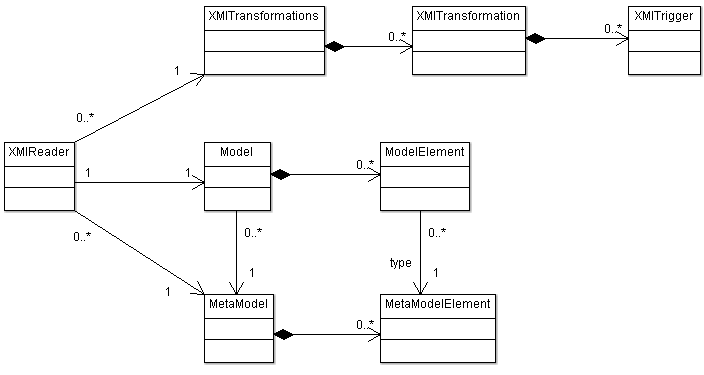-
Interface Summary Interface Description XMIReader.ProgressMessageHandler Message handler for progress messages of the XMI parser. -
Class Summary Class Description MetaModel Represents an SDMetrics metamodel.MetaModelElement Represents an element type of the SDMetrics metamodel.Model Container for the model elements of the UML design to be analyzed.ModelElement Represents a model element of a model.XMIReader Reads an XMI source file, processing it as specified by an XMI transformation file.XMITransformations Container and XML parser for XMI transformations.
Package com.sdmetrics.model Description
Provides the XMI import of UML models and access to the elements of the imported model.

Tutorial - how to parse an XMI file and access the model elements
The following code snippets take you through the steps to parse an XMI file, and write out all model elements extracted from the XMI file to the console.
- Required imports:
import java.util.Collection; import java.util.List; import sdmetrics.model.MetaModel; import sdmetrics.model.MetaModelElement; import sdmetrics.model.Model; import sdmetrics.model.ModelElement; import sdmetrics.model.XMIReader; import sdmetrics.model.XMITransformations; import sdmetrics.util.XMLParser;
- Have your metamodel, XMI transformation, and XMI input files ready:
String metaModelURL = ...; // metamodel definition to use String xmiTransURL = ...; // XMI tranformations to use String xmiFile = ...; // XMI file with the UML model
- Read the metamodel
You do not have to use the SAX parser provided by classXMLParserparser = new XMLParser();MetaModelmetaModel = new MetaModel(); parser.parse(metaModelURL, metaModel.getSAXParserHandler());XMLParser, you may just as well use aorg.xml.sax.XMLReaderthat you created yourself. - Read the XMI transformation file
XMITransformationstrans=new XMITransformations(metaModel); parser.parse(xmiTransURL, trans.getSAXParserHandler()); - Read the XMI file with the UML model
Modelmodel = new Model(metaModel);XMIReaderxmiReader = new XMIReader(trans, model); parser.parse(xmiFile, xmiReader); - Optionally, specify element filters to get rid of standard libraries or 3rd party APIs
String[] filters = { "#.java", "#.javax", "#.org.xml" };At this point, you can already start calculating metrics for the elements in the model. The tutorial for packagemodel.setFilter(filters, false, true);com.sdmetrics.metricsdescribes how. The remainder of this tutorial shows how to access the elements in the model. - Access the UML model
The following example writes all model elements accepted by the element filter to the console, along with the values of their attributes.// iterate over all model element types in the metamodel for (
MetaModelElementtype : metaModel) { System.out.println("Elements of type: " + type.getName()); // iterate over all model elements of the current type List<ModelElement> elements = model.getAcceptedElements(type); for (ModelElementme : elements) { System.out.println(" Element: " + me.getFullName() + " "); // write out the value of each attribute of the element Collection<String> attributeNames = type.getAttributeNames(); for (String attr : attributeNames) { System.out.print(" Attribute '" + attr); if (type.isSetAttribute(attr)) System.out.println("' has set value " + me.getSetAttribute(attr)); else if (type.isRefAttribute(attr)) { System.out.print("' references "); ModelElement referenced = me.getRefAttribute(attr); System.out.println((referenced == null) ? "nothing" : referenced.getFullName()); } else System.out.println("' has value: " + me.getPlainAttribute(attr)); } } }